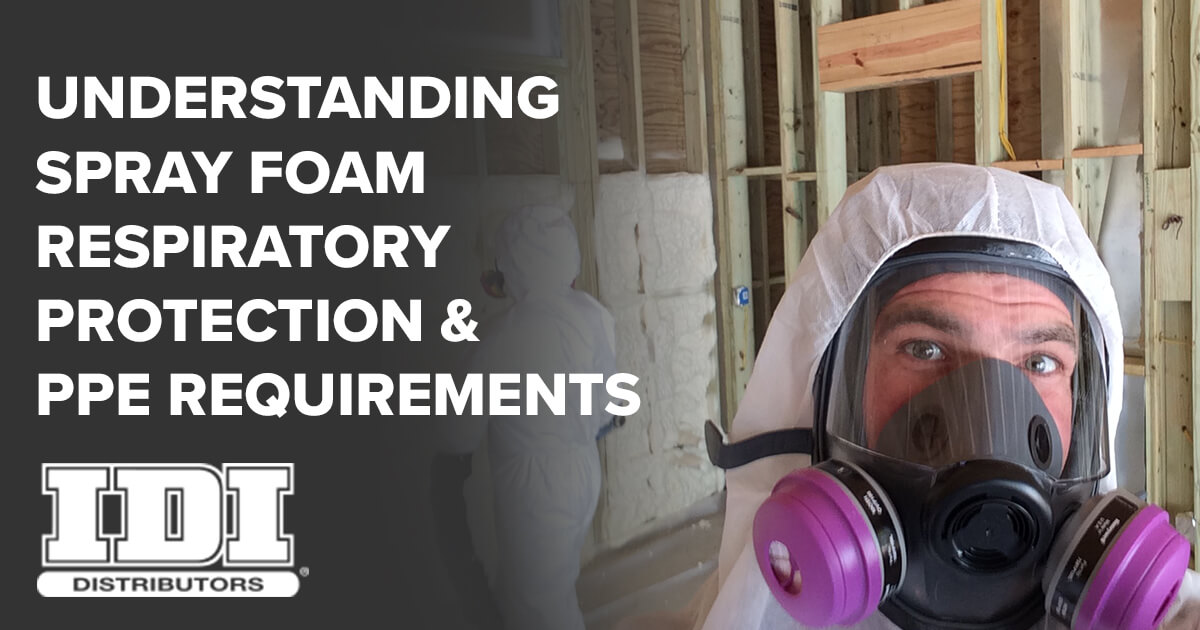Most of us want to live long enough to spend time with our grandchildren and still enjoy a few years of good health. I’m talking about the years after we are done hanging out in attics or crawl spaces and subjecting our bodies to all the dust, biologicals, and chemicals we try to protect ourselves from.

Safety IS the Priority and Safety Masks Are at the Top of the List
I’ll be the first to admit, years ago PPE (personal protective equipment) just seemed like a hassle to me. Unless I was coughing, why would I want to wear one more thing that made it harder to breathe or move around? As I get older, I realize all that demolition and removal may have kept me in shape, but it didn’t do my lungs any favors. Demolition aside though, what about spraying heated industrial adhesive and catalysts?
No one should be breathing the fine mist of chemicals produced when installing SPF. Certainly everyone’s body has different tolerances, but the risk of exposure and sensitization to these chemicals should motivate all of us to wear proper PPE. The potential of decreased lung function is enough to persuade most people, but what about the threat of experiencing adult onset asthma? As employers, installers, and suppliers, we should be trying to help each other do the right thing for our health and safety.
Spray Foam PPE Requirements
Interior and exterior spray foam PPE requirements are listed here and are summarized as follows:
- When spraying an interior application, the requirements are for the sprayer and anyone working within 25 feet to be breathing supplied air. This can be done with a tight fitting, full face, SAR (supplied air respirator) or hood. Note: You can learn more about supplied air respirators and the brands IDI offers by visiting our Respiratory Protection Masks and Hoods webpage.
- When spraying an exterior application, the requirements allow for the use of a full-face air-purifying respirator with organic vapor/particulate (P100) cartridges, or supplied air.
- Remember, there are two hazards we need to be protected from…VOC and particulate. Protection from one or the other is not sufficient and poses health hazards. A NIOSH approved system must provide protection via supplied air (SAR), or the proper filter combo being P100. A VOC cartridge is not sufficient without the approved particulate pre-filter in place.
- OSHA also requires that all components of a fresh air system are from the same manufacturer, because they are tested as a system.
Tracking Respirator Cartridge Use
In addition to spray foam PPE requirements, it’s also important to note that respirator cartridges do not have eternal life and thus, users should make sure to track the following each time a cartridge is used:
- The amount of time the respirator has been worn (both in terms of minutes and cumulative)
- The location the respirator has been worn
- Confirmation the respirator was cleaned after use (sanitized or wiped down using an alcohol wipe, then placed in a sealed bag)
After eight total hours of use, cartridges should not be used again. Tracking everything can go a long way towards ensuring you stay safe by not using respirator cartridges that have already reached their end of service dates. You can use this log to help keep track of your changeout schedule.
Isocyanate, Solvents, & Chemicals
Even when working in the trailer, any sanding, grinding, or dust we make when removing isocyanate from a surface, can cause sensitization. And iso is not the only concern we should have. The solvents or chemicals we use can have dramatic effects on our bodies. We should avoid making chemical mixtures in an attempt to speed up the removal process. Additionally we never want to breathe them. Heating them can be dangerous and may increase their concentration levels in the air. I wouldn’t go as far as making a bumper sticker that said “real men wear masks”. (It might give a bad impression) But we do want to do everything we can to get them to wear masks, gloves, and all of the safety equipment necessary for the work they are doing.
The safety of you and your crew is our top priority. To help you train your crews on safety masks or familiarize yourself with the different PPE products and requirements, IDI has put together a short video you can share with your team.
We are also making June our Safety Supplies and Awareness Month. During the month, we will be offering discounts on masks, head socks, fresh air equipment, safety glasses and goggles, cooling vests and much more. To see the great deals going on, check out our promotions here, or contact us directly. You can also reach out to your local rep with any questions.